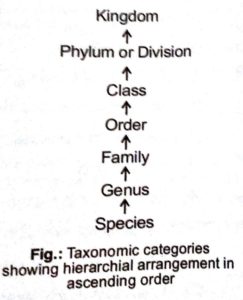TAXONOMIC CATEGORIES
Classification is not a single step process. It involves hierarchy of steps in which each step represents a rank or category. The category is a part of overall taxonomic arrangement. So, it is known as the taxonomic category. All categories together make taxonomic hierarchy. Each category is also termed as a unit of classification. It represents a rank and is commonly called as taxon. The taxon must be recognizable and should belong to a category. It is a series of different ranks placed in ascending or descending order. It was Linnaeus who for the first time introduced five categories in the taxonomic hierarchy, vix., class, order, genus, species and variety, later on three more categories, vix., kingdom , division or phylum and family were added and variety was discarded to make a hierarchy of seven obligate categories, viz., kingdom- division (in plants ) or phylum (in animals) – class – order –family – genus – species.
Higher the category, higher is the number of organisms in it. Higher the category, fewer will be the number of common characters and greater is the difficulty of determining the relationship to other taxa at the same level. Hence, the problem of classification becomes more complex.
Taxonomic categories and hierarchy can be illustrated by an example. Insects represent a group of organisms sharing common features like three pairs of jointed legs. It means insects are recognizable concrete objects which can be classified, and thus were given a rank or category. Similarly, mammals represents animals with external ears, body hairs, mammary glands etc. dog, mammals, animals are all taxa but of different categories. Taxon dog, mammals and animals represent categories like species, class and kingdom respectively. Different rank or categories of taxonomic hierarchy are discussed and shown in figure.
Species :
Term given by John Ray.
It is lowest category of classification.
It is a group of closely related individuals with similar morphological, anatomical, biochemical and cytological characters.
It is a group of naturally interbreeding population with the ability to produce fertile off springs.
Individuals of a species share common gene pool.
It is reproductively isolated, thus genetically closed system.
e.g., Pisum sativum – Pea
Mangifera indica – Mango
Solanum tuberosum – Potato
Panthera leo – Lion
Homo sapiens – Human being
In these, sativum, indica, tuberosu, leo, sapiens represent the specific epithet, while Pisum, Mangifera, Solanum, Panthera and Homo represent genus.
Genus :
It is a group of related species which has more characters in common in comparison to species of other genera.
e.g., Potato, (Solanum tuberosum), makoi (S. nigrum), and brinjal (S.Melongena) are three different species belonging to same genus Solanum.
Lion, leopard and tiger with several common features belong to the same genus Panthera.
Family :
It is a group of related genera with still less number of similarities as compared to genus and species. Families are characterized on the basis of both vegetative and reproductive features of plants. For example, four related genera Solanum, Petunia, Datura and Atropa belong to family Solanaceae. Genus Panthera and Felis (cat) are put together in family Felidae.
Order :
It is a group of related families which exhibit a few similar characters. The similar characters are less in number as compared to different genera included in a family.
For example, plant families like Convolvulaceae and Solanaceae are included in order Polymoniales mainly based on floral characters.
In animals, order carnivore includes families like Felidae and Canidae (dog).
Class :
It is a group of related orders.
For example, plants order like Sapindales (mango) and Ploymoniales are included in Class – Dicotylednoae, Order – Volvocaies (volvox) and Conjugales (Spirogyra) are included in Class- Chlorophyceae (green algae).
Phylum / Division :
It is a group of related classes. The phylum Chordata of animals contains not only the class mammalia but also aves (birds), reptilian (reptiles) amphibian (amphibians) and osteichthyes (fishes). In case of plants, classes with few similar characters like dicots and monocots constitute division – Angiospermae. The category phylum is used in animalia while division is used in plantae.
Concept of Species :
Biological concept of species ( was given by Ernst Mayr) : Species is the fundamental unit of classification. A species is a group of organisms (i) which are closely related ( structurally and functionally) sharing a common gene pool (ii) which can interbreed freely in nature and produce fertile offspring in a natural environment. This concept of species is based upon reproductive isolation and called biological concept.
Some important interspecific hybrids (exception of biological concept of species)
- Sterile Hybrid (under natural conditions)
Mule = Between male donkey and female horse (Mare)
Hinny = Between male horse (Stallion) and female donkey
- Fertile Hybrid ( under captive conditions)
Tigon = Between male tiger and female lion
Liger = Between male lion and female tiger
